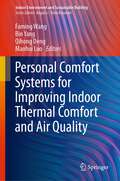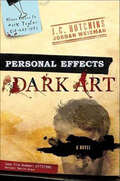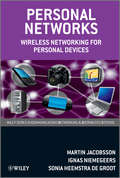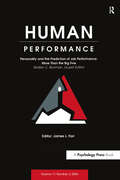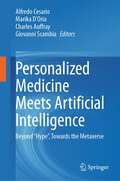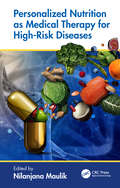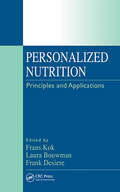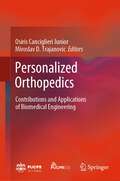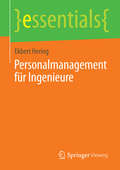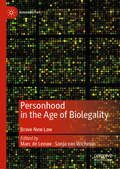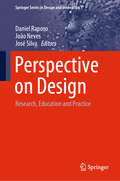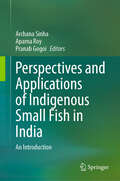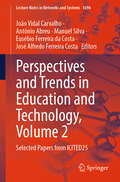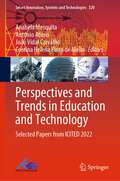- Table View
- List View
Person-Centred Care in Radiology: International Perspectives on High-Quality Care (Medical Imaging in Practice)
by Karen Knapp Christopher Hayre Emma Hyde Chau, Edited by ShayneThis edited book focuses on the application of patient care within the three specialisms: diagnostic radiography (including fluoroscopy, computed tomography, breast imaging, ultrasound, and magnetic resonance imaging), radiotherapy and oncology, and nuclear medicine and molecular imaging.Person-Centred Care in Radiology: International Perspectives on High-Quality Care draws from recent publications and clinical expertise, supported with this trend of technological advances and how they are supposed to enhance patient care. The chapters seek to uncover the role and behavior of radiographers. This will be supported with chapters on a key aspect, which will impact both radiographers and patients, vis-à-vis advancing technology. These chapters include topics such as artificial intelligence, image acquisition, coincided with topics surrounding ethics. The edited volume includes contributions from the United States, Canada, the UK and Australasia to bring together for the first time those at the forefront of this growing field in medical imaging.This book may be used to influence policymaking decisions and thus influence how healthcare delivery is offered in an ever-evolving imaging environment. In short, this text bridges the gap between what is advocated in the literature, with experience, as observed in practice. The targeted audience for this book is multifaceted. It will primarily be a book that facilitates undergraduate radiography students worldwide. It will offer a useful tool for academics delivering undergraduate (pre-registration) radiography programs.This book will act as a ‘primer’ for undergraduate students, but importantly ‘signpost’ to other key texts within the field. Further, academics will find this text useful as it aims to enrich scholarly learning, teaching and assessment to healthcare programs nationally and internationally.
Personal Comfort Systems for Improving Indoor Thermal Comfort and Air Quality (Indoor Environment and Sustainable Building)
by Bin Yang Faming Wang Maohui Luo Qihong DengThis book first describes fundamental knowledge on human thermal comfort, adaptive thermal comfort, thermal comfort in sleeping environments, modeling of human thermal comfort, and thermal comfort assessment using human trials. Next, it presents an in-depth review of concept progress and evaluation of various personal comfort system, summarizes important findings and feasible applications, current gaps as well as future research needs. The seven chapters included in this section are task/ambient conditioning systems, personalized ventilation systems, electric fans, personal comfort systems, thermoelectric systems, personal thermal management systems, and wearable personal thermal comfort systems. This book provides valuable guidance for personal comfort system design and further improvement on the personal comfort performance. It will be a valuable resource for academic researchers, engineers in industry, and government regulators in the field of sustainable buildings and built environment.
Personal Data in Competition, Consumer Protection and Intellectual Property Law: Towards A Holistic Approach? (Mpi Studies On Intellectual Property And Competition Law Ser. #28)
by Mor Bakhoum Beatriz Conde Gallego Mark-Oliver Mackenrodt Gintarė Surblytė-NamavičienėThis book analyses the legal approach to personal data taken by different fields of law. An increasing number of business models in the digital economy rely on personal data as a key input. In exchange for sharing their data, online users benefit from personalized and innovative services. But companies’ collection and use of personal data raise questions about privacy and fundamental rights. Moreover, given the substantial commercial and strategic value of personal data, their accumulation, control and use may raise competition concerns and negatively affect consumers. To establish a legal framework that ensures an adequate level of protection of personal data while at the same time providing an open and level playing field for businesses to develop innovative data-based services is a challenging task.With this objective in mind and against the background of the uniform rules set by the EU General Data Protection Regulation, the contributions to this book examine the significance and legal treatment of personal data in competition law, consumer protection law, general civil law and intellectual property law. Instead of providing an isolated analysis of the different areas of law, the book focuses on both synergies and tensions between the different legal fields, exploring potential ways to develop an integrated legal approach to personal data.
Personal Effects: A Novel
by Jordan Weisman J. C. HutchinsWant to try it yourself? Call the phone number shown on book's cover: 212-629-1951 and listen to the voicemail message for main character Zach Taylor.Personal Effects follows the extensive notes of therapist Zach Taylor's investigation into the life and madness of Martin Grace, an accused serial killer who claims to have foreseen, but not caused, his victims' deaths. Zach's investigations start with interviews and art sessions, but then take him far from the hospital grounds—and often very far from the reality that we know. The items among Grace's personal effects are the keys to understanding his haunted past, and finding the terrifying truth Grace hoped to keep buried: • Call the phone numbers: you'll get a character's voicemail. • Google the characters and institutions in the text: you'll find real websites • Examine the art and other printed artifacts included inside the cover: if you pay attention, you'll find more information than the characters themselves discover Personal Effects, the ultimate in voyeuristic storytelling, represents a revolutionary step forward in changing the way people interact with novels.
Personal Media and Everyday Life: A Networked Lifeworld
by Terje RasmussenThis book addresses the widespread use of digital personal media in daily life. With a sociological and historical perspective, it explores the media-enhanced individualization and rationalization of the lifeworld, discussing the dramatic mediatization of daily life and calling on theorists such as McLuhan, Habermas and Goffman.
Personal Networks
by Sonia Heemstra de Groot Ignas Niemegeers Martin JacobssonWritten by experts in the field, this book describes the Personal Network architecture and its various componentsThis book focuses on networking and security aspects of Personal Networks (PNs). Given a single user, the authors propose an architecture for PNs in which devices are divided into one of two types of nodes: personal nodes and foreign nodes. Furthermore, the authors demonstrate the ways in which PNs can be formed in a self-organized and secure way, how they can be interconnected using infrastructure networks, how multiple PNs can be connected, and how their services and resources can be shared. In addition, the book shows how security and ease-of-use can be achieved through automatic configuration and how mobility can be supported through adaptability and self-organization. The motivations for the PN concept, the PN architecture, its functionalities and features, as well as future challenges are covered in depth. Finally, the authors consider the potential applications for PNs and briefly discuss additional support systems for PN applications. The latter includes service discovery and context information management among others.Key Features:Describes the PN network architecture and its various components in-depthWritten by experts who developed this conceptDiscusses the newer topic of federations of PNsConsiders potential PN applications, and demonstrates how applications support systems, such as service discovery and context management, can assist the applicationsProvides an insight into the challenges of future personal networking, architectures for PNs, potential and important solutions, and their implicationsThis book will serve as an invaluable reference for researchers, developers, and standardization experts in mobile and wireless communication systems and services. It will also be of interest to postgraduate students in the field of telecommunications.
Personal Protective Equipment for Chemical, Biological, and Radiological Hazards: Design, Evaluation, and Selection
by Eva F. Gudgin DicksonPersonal protective equipment (PPE) is critical for those dealing with toxic, infectious, and radioactive materials. <P><P>An easily accessible guide for professionals and researchers in all PPE fields, this book takes a fresh look at how PPE is designed, selected, and used in today's emergency response environment where users may need to be protected against deliberately used chemical, biological, or radiological agents in terrorism or warfare scenarios as well as more traditional hazards. Covering the physics, chemistry, and physiology of these hazards, the book explains how PPE protects from various forms of hazards as well as how to use this information to select PPE against these highly hazardous substances for first responder or military users. The design of PPE and components plus relevant performance and evaluation standards are also discussed.
Personal Robotics: Real Robots to Construct, Program, and Explore the World
by Richard RaucciMany companies are now offering robots that are geared to the casual electronics hobbyist, both in kit form and as fully assembled models. This book gives an overview of available robot products, ranging from the simple to the complex. Interested readers will be able to find the robot kit that matches their skill level and pocketbook. Beginners may want to try a robot that is already fully assembled, or a kit with pre-assembled electronics. Other readers may opt for kits that require soldering and electronic experience. Other criteria a reader will be able to review include motion systems (robots that roll on wheels, or walk on legs, or robot arms), available sensors (from none to a wide range), and programming complexity (how the robot is programmed). If its not really a robot, its not in this book.
Personal für die additive Fertigung: Kompetenzen, Berufe, Aus- und Weiterbildung (essentials)
by Herbert MarschallDas essential bietet eine Orientierungshilfe zu erforderlichen Kompetenzen und den verschiedenen Angeboten beruflicher Bildung im Bereich der generativen Fertigung. Herbert Marschall zeigt Strategien auf, um im Rahmen der gegebenen institutionellen Möglichkeiten mehr Inhalte zu generativer Fertigung im deutschen Aus- und Weiterbildungssystem zu implementieren und dem Fachkräftemangel auf diese Weise erfolgreich zu begegnen. Umfangreiche Tabellen ermöglichen dem Leser eine schnelle und detaillierte Übersicht über alle wichtigen Aspekte.
Personalising Human-Robot Interactions in Social Contexts (Springer Tracts in Advanced Robotics #159)
by Carme Torras Antonio Andriella Guillem AlenyàThis book offers an insightful exploration of the pivotal role of robots in our ever-changing society. As intelligent machines become increasingly integrated into various aspects of our lives, their impact on how we live, work, and interact becomes undeniable. Within these pages, the book delves into the key concept of personalisation, unravelling the profound importance of tailoring robotic interactions to meet the unique needs and preferences of individuals. This exploration seeks to foster a deeper understanding of how robots can enhance our lives and potentially be a worthwhile technology to address some important societal issues. To showcase that, the book centres on a practical use case that is built upon collaboration with healthcare experts: designing personalised robots for assisting patients affected by cognitive decline. With over 50 million people affected by dementia worldwide and an expected tripling of this number by 2050, the need for effective and accessible treatments is more pressing than ever. While there are no pharmacological treatments for this syndrome, cognitive training has shown promise for maintaining and even improving cognitive functioning among dementia patients. However, the shortage of healthcare professionals capable of delivering such therapy presents a significant challenge. This is where the potential of robots comes into play. This book delves into the potential of robotic technology designed to bridge this societal gap. By taking a therapist-oriented approach, it investigates the insights that can be gleaned from involving therapists in the entire pipeline of the design process as well as in the automatisation of the robots' assistive behaviour. Specifically, this book aims to address personalisation from two complementary perspectives by designing robots that are both adaptable and adaptive.
Personalising Learning in Teacher Education
by Mellita Jones Karen McLeanThis volume sheds light on debates about personalised learning in teacher education by exploring the popular emergence of personalising learning in education and hence its significance in teacher education in the 21st century. It examines personalising learning theory and explores the tenets of this theory and its recent trends in international settings. The theory is explored in relation to both general and higher education pedagogy, and in a range of examples within a teacher education context. The examples from practice provide insights into maximising the potential for personalising learning theory to enhance teaching, learning and assessment in teacher education. The book includes case studies involving pre-service teachers working in communities of practice with one another, with schools and with the wider community. Examples of technology for personalising learning are also described. All the case studies demonstrate how the learner is made central to the teaching and assessment approaches adopted and contributes to a lifelong learning continuum. Providing insights into a new pedagogy for teacher education that leads to an enriched student experience, the book presents a model for personalising learning in teacher education that offers support for 21st century teacher educators.
Personality and the Prediction of Job Performance: More Than the Big Five: A Special Issue of Human Performance
by Walter C. BormanThe three primary papers in this special issue explore personality measurement in both directions, that is, more narrow and specific and more broad and heterogeneous. The first paper reviews research on conditional reasoning, with a focus on the construct of aggression. Next, tolerance for contradiction is explored, which is defined as a mode of thinking that accepts and even thrives on apparent contradictory information. The last primary paper covers core self evaluation, which combines measures of four traits: locus of control, self-esteem, generalized self-efficacy, and emotional stability. The special issue concludes with provocative and insightful critique and commentary of the three primary papers. It notes some important points of criticism, but is primarily positive and laudatory of these research programs.
Personalized Medicine Meets Artificial Intelligence: Beyond “Hype”, Towards the Metaverse
by Alfredo Cesario Marika D’Oria Charles Auffray Giovanni ScambiaThe book provides a multidisciplinary outlook on using Artificial Intelligence (AI)-based solutions in the field of Personalized Medicine and its transitioning towards Personalized Digital Medicine.The first section integrates different perspectives on AI-based solutions and highlights their potential in biomedical research and patient care. In the second section, the authors present several real-world examples that demonstrate the successful use of AI technologies in various contexts. These include examples from digital therapeutics, in silico clinical trials, and network pharmacology. In the final section of the book, the authors explore future directions in AI-enhanced biomedical technologies and discuss emerging technologies such as blockchain, quantum computing and the “metaverse”. The book includes discussions on the ethical, regulatory, and social implications for an AI-based personalized medicine. The integration of heterogeneous disciplines brings together multiple stakeholders and decision makers involved in the personalization of care. Clinicians, students, and researchers from academia and the industry can benefit from this book, since it provides foundational knowledge to drive advances in personalized biomedical research and health care.
Personalized Nutrition as Medical Therapy for High-Risk Diseases
by Nilanjana MaulikPersonalized nutrition involves the formulation of individualized nutritional recommendations to promote and maintain health based on an individual's genetic makeup and other unique intrinsic and extrinsic factors. Implementing personalized nutrition plans for individuals with certain diseases or who are in danger of developing health conditions could help control the onset and severity of symptoms. Personalized Nutrition as Medical Therapy for High-Risk Diseases offers a practical guide for physicians seeking to provide tailored dietary recommendations to their patients with disease treatment, modulation and prevention in mind. The book focuses on the biological mechanisms of specific diseases and provides evidence for how personalized nutrition positively impacts them. It explores conditions including cardiovascular diseases, hypertension, hypercholesteromia, diabetes, obesity, Crohn's disease, as well as multiple pediatric, renal and psychological disorders. Features: · Includes case studies that document how people respond differently towards food depending on their genetic structure and other factors. · Discusses genome wide association studies (GWIMS) to understand the interplay between genetic susceptibility and dietary interactions. · Provides users information to effectively implement personalized nutrition into practice. · Identifies possible challenges to the implementation of personalized nutritional interventions in a clinical setting. This book is for medical practitioners and will also appeal to researchers and students.
Personalized Nutrition: Principles and Applications
by Frans Kok Laura Bouwman Frank DesiereFrom one person to the next, optimal health is governed by a huge array of minor genetic differences. When modulated by a variety of food bioiactives, these differences result in changes in gene expression and subsequent phenotypic expression. Combining biomedical and social science with contributions from leaders in both fields, Personalized Nutri
Personalized Orthopedics: Contributions and Applications of Biomedical Engineering
by Osiris Canciglieri Junior Miroslav D. TrajanovicThis book covers the most important topics in the field of personalized orthopedics. It starts with the 3D geometry of the bones, focusing on the problem of reverse engineering of the bones. It also shows the application of a 3D geometric model of bone for the design of personalized implants and prostheses. This book covers the application of additive technologies in personalized orthopedics as well as prediction, simulation and optimization in personalized orthopedics. Its content provides the necessary knowledge for the transition from classical to personalized orthopedics. The authors present an original method for reverse bone engineering—the Method of Anatomical Features (MAF). This method is unique as it enables the reconstruction of the original geometry and topology of the bone, even when only data on its part are available. The application of this method is shown on the examples of human long bones, mandible and hip bone reconstruction. This book contains a review of several real cases of personalized implants. It gives several examples of prostheses for the design of which a 3D model of bones was used, as well as other patient data on the basis of which personalized prostheses were designed.
Personalizing Haptics: From Individuals' Sense-Making Schemas to End-User Haptic Tools (Springer Series on Touch and Haptic Systems)
by Hasti SeifiThis monograph presents a vision for haptic personalization tools and lays the foundations for achieving it. Effective haptic personalization requires a suite of tools unified by one underlying conceptual model that can easily be incorporated into users’ workflows with various applications. Toward this vision, the book introduces three mechanisms for haptic personalization and details development of two of them into: 1) an efficient interface for choosing from a large haptic library, and 2) three emotion controls for adjusting haptic signals. A series of quantitative experiments identifies five schemas (engineering, sensation, emotion, metaphor, and usage examples) for how end-users think and talk about haptic sensations and characterizes them as the underlying model for the personalization tools. Personalizing Haptics highlights the need for scalable haptic evaluation methodologies and presents two methodologies for large-scale in-lab evaluation and online crowdsourcing of haptics. While the work focuses on vibrotactile signals as the most mature and accessible type of haptic feedback for end-users, the concepts and findings extend to other categories of haptics. Taking haptics to the crowds will require haptic design practices to go beyond the current one-size-fits-all approach to satisfy users’ diverse perceptual, functional, and hedonic needs reported in the literature. This book provides a starting point for students, researchers, and practitioners in academia or industry who aim to adapt their haptic and multisensory designs to the needs and preferences of a wide audience.
Personalmanagement für Ingenieure (essentials)
by Ekbert HeringMitarbeiter sind die wichtigste Ressource eines Unternehmens. Geeignetes Personal zu finden und an das Unternehmen zu binden, gehört daher zu den wichtigsten und erfolgsentscheidenden Aufgaben im Unternehmen. Gerade Ingenieure übernehmen im Laufe ihrer Karriere immer mehr Personalverantwortung. Deshalb sind die Kenntnisse über Personalmanagement für Ingenieure sehr wichtig. Im Mittelpunkt steht dabei die Persönlichkeit eines Menschen. Anhand des Verhaltensmodells nach persolog® werden verschiedene Persönlichkeitsprofile aufgezeigt sowie deren Stärken und Schwächen vorgestellt (beispielsweise für Konstrukteure oder Innovatoren). Wichtig ist dabei, dass die Mitarbeiter entsprechend ihren Stärken richtig eingesetzt werden. Ausführlich werden die Methoden der Personalfindung, der Personalbindung, der Mitarbeiterbeurteilung und Entlohnung sowie der Personaltrennung behandelt.
Personalmanagement in Zeiten des Fachkräftemangels: Schnelleinstieg für Architekten und Bauingenieure (essentials)
by Dietmar GoldammerAufgrund des Wandels in unserer Gesellschaft wird es Veränderungen in den Unternehmen geben, die auch vor den Planungsbüros nicht haltmachen. Dieser Wandel betrifft auch das Personalmanagement. Der Autor gibt Tipps, wie man sich dabei in Zukunft aufstellen könnte.Der Autor:Dr. Dietmar Goldammer ist Diplom-Kaufmann und Unternehmensberater für Architekten und Ingenieure. Er gibt als Dozent Seminare zur Betriebswirtschaft für Planer und ist Fachbuchautor zahlreicher Publikationen zum Thema Betriebswirtschaft. Er ist Vorstandsmitglied der Praxisinitiative erfolgreiches Planungsbüro (PeP) in Berlin.
Personhood in the Age of Biolegality: Brave New Law (Biolegalities)
by Marc De Leeuw Sonja Van WichelenThis volume showcases emerging interdisciplinary scholarship that captures the complex ways in which biological knowledge is testing the nature and structure of legal personhood. Key questions include: What do the new biosciences do to our social, cultural, and legal conceptions of personhood? How does our legal apparatus incorporate new legitimations from the emerging biosciences into its knowledge system? And what kind of ethical, socio-political, and scientific consequences are attached to the establishment of such new legalities? The book examines these problems by looking at materialities, the posthuman, and the relational in the (un)making of legalities. Themes and topics include postgenomic research, gene editing, neuroscience, epigenetics, precision medicine, regenerative medicine, reproductive technologies, border technologies, and theoretical debates in legal theory on the relationship between persons, property, and rights.
Perspective on Design: Research, Education and Practice (Springer Series in Design and Innovation #1)
by José Silva Daniel Raposo João NevesThis book presents the outcomes of recent endeavors that are expected to foster significant advances in the areas of communication design, fashion design, interior design, and product design, as well as overlapping areas. The fourteen chapters highlight carefully selected contributions presented during the 6th EIMAD conference, held on February 22–23, 2018 at the School of Applied Arts, Campus da Talagueira, in Castelo Branco, Portugal. They report on outstanding advances that offer new theoretical perspectives and practical research directions in design, and which are aimed at fostering communication in a global, digital world, while also addressing key individual and societal needs.
Perspectives and Applications of Indigenous Small Fish in India: An Introduction
by Archana Sinha Aparna Roy Pranab GogoiThis contributed volume covers all aspects of small indigenous fish for nutritional and livelihood security. The availability, descriptions and identification of common small indigenous fish provides potential and prospects of fish production from inland open water system. In addition, individual chapters are added on growth, feeding, diseases and health management of these small fishes. Essential information is provided on packaging and transport of these fishes. Specific chapters provide information on nutritional value of fishes, value addition and product development by using small indigenous fish species in different regions of the country. Further topics include small fishes of ornamental value, indigenous technical knowledge, climate change impact, conservation and management of small indigenous fish diversity. This book supports the academicians, farmers, entrepreneurs and fisheries professionals involved in gaining the knowledge and skills needed to contribute in nutritional and livelihood security of the nation.
Perspectives and Trends in Education and Technology, Volume 2: Selected Papers from ICITED25 (Lecture Notes in Networks and Systems #1694)
by António Abreu Manuel Silva João Vidal Carvalho Eusébio Ferreira da Costa José Alfredo Ferreira CostaThis book from the LNNS Series is composed of the best selected papers accepted for presentation and discussion at the 2025 International Conference in Information Technology & Education. The ICITED is a multidisciplinary conference with a special focus on new Technologies and Systems in the Education sector and was held between July 10 and 12, 2025. The ICITED&’25 was supported by the Federal University of Rio Grande do Norte, in Natal, Brazil and by IADITI—International Association for Digital Transformation and Technological Innovation. This book is intended for researchers, academics, lecturers, specialists, professionals, doctoral and master's students, undergraduates, and practitioners working in Information Technology and Computer Science in Education area.
Perspectives and Trends in Education and Technology: Selected Papers from ICITED 2021 (Smart Innovation, Systems and Technologies #256)
by Anabela Mesquita António Abreu João Vidal CarvalhoThis book presents high-quality, peer-reviewed papers from the International Conference in Information Technology & Education (ICITED 2021), to be held at the ESPM – Higher School of Advertising and Marketing, Sao Paulo, Brazil, between the 15th and the 17th of July 2021. The book covers a specific field of knowledge. This intends to cover not only two fields of knowledge – Education and Technology – but also the interaction among them and the impact/result in the job market and organizations. It covers the research and pedagogic component of Education and Information Technologies but also the connection with society, addressing the three pillars of higher education. The book addresses impact of pandemic on education and use of technology in education. Finally, it also encourages companies to present their professional cases which is discussed. These can constitute real examples of how companies are overcoming their challenges with the uncertainty of the market.
Perspectives and Trends in Education and Technology: Selected Papers from ICITED 2022 (Smart Innovation, Systems and Technologies #320)
by Anabela Mesquita António Abreu João Vidal Carvalho Cristina Helena Pinto de MelloThis book presents high-quality, peer-reviewed papers from the International Conference in Information Technology & Education (ICITED 2022), to be held at the ESPM – Higher School of Advertising and Marketing, Rio de Janeiro, Brazil, between July 14 – 16, 2022. This book covers a specific field of knowledge. This intends to cover not only two fields of knowledge – Education and Technology – but also the interaction among them and the impact/result in the job market and organizations. It covers the research and pedagogic component of Education and Information Technologies and also the connection with Society, addressing the three pillars of higher education. This book addresses impact of pandemic on education and use of technology in education. Finally, it also encourages companies to present their professional cases which will be discussed. These can constitute real examples of how companies are overcoming their challenges with the uncertainty of the market.

